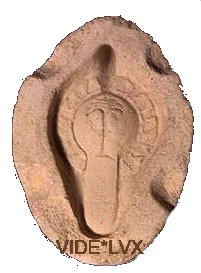
Original late Roman period mould from North Africa

Reproduction mould

Original late Roman period mould from North Africa

Original late Roman period mould from North Africa |

Reproduction mould |

Original late Roman period mould from North Africa |
Ancient lamp moulds were made from many materials. Clay, stone, and gypsum (plaster) were the most common. The notches seen in the moulds above allow for the top and bottom halves to be joined securely after being filled with sheets of wet clay. Plaster moulds work well in this process as the plaster draws moisture from the clay and helps the lamp to dry faster. The resulting lamps are removed before they dry out completely, but after they dry enough to release from the mould. Excess clay is trimmed and holes are pierced.